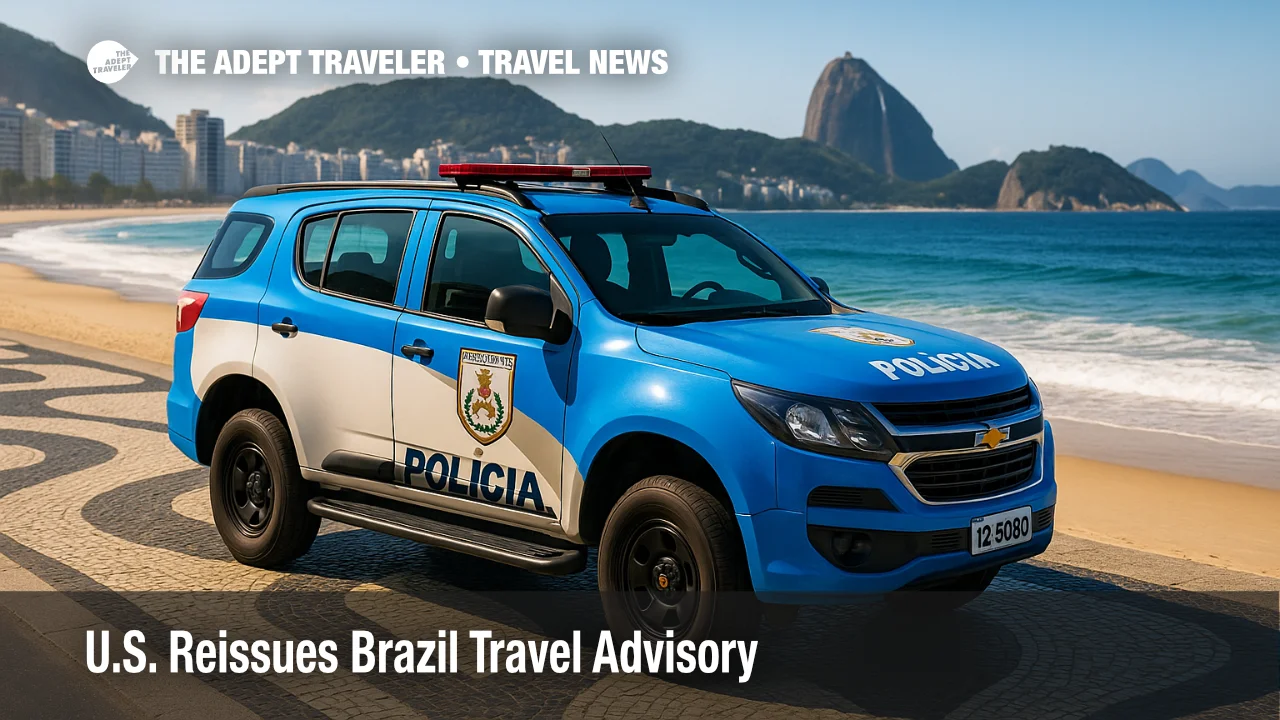U.S. Reissues Brazil Travel Advisory

The U.S. State Department has reissued a Level 2 alert for Brazil, urging travelers to exercise increased caution due to crime and kidnapping. The August 8 update highlights risks in major cities and specifies zones to avoid, including informal settlements, certain suburbs at night, and wide swaths of land borders. Officials also note schemes that target foreigners through dating apps or at bars, often involving drink-spiking and robbery. U.S. personnel are advised not to use municipal buses because of frequent robberies, especially after dark.
Key Points
- Why it matters: The Brazil travel advisory underscores persistent urban crime risks and targeted scams.
- Travel impact: Expect tighter personal-security planning, limited use of public buses, and more ride-hail or taxis.
- What's next: Officials will update guidance as conditions evolve and local enforcement priorities shift.
- Exceptions and rules vary by region, so review city-specific advice before booking.
- Enroll in STEP and keep copies of IDs, itineraries, and emergency contacts.
Snapshot: Brazil travel advisory
Brazil remains open to tourism, but the renewed Level 2 alert asks you to heighten situational awareness. Authorities cite violent crime in urban areas at all hours, plus incidents where victims are drugged and robbed after meeting contacts on apps or in nightlife districts. Travelers are warned to avoid informal settlements and to stay away from municipal buses, where robberies are common, especially at night. Border areas within roughly 100 miles are generally off-limits, with carved-out exceptions for major national parks. The advisory favors common-sense steps, including staying in well-lit areas, using registered transport, and not resisting if confronted.
Background
The State Department's four-tier system ranges from Level 1, exercise normal precautions, to Level 4, do not travel. Brazil has remained at Level 2 for several years, reflecting ongoing safety issues without a blanket warning against travel. Urban crime patterns, organized criminal activity tied to the drug trade, and opportunistic theft continue to shape risk in cities large and small. Recent advisories emphasize specific tactics that target visitors, including drink-spiking and app-based lures. The updated guidance balances those risks with practical steps for safer travel, focusing on route planning, transportation choices, and behavior in nightlife corridors. It also flags neighborhoods and regions that warrant extra caution or outright avoidance.
Latest Developments
State Department renews Level 2 guidance
The August 8 update keeps Brazil at Level 2, exercise increased caution. Officials highlight violent crime in urban areas at any hour and reference a kidnapping for ransom involving U.S. travelers, alongside gang activity linked to the recreational drug trade. The advisory also calls out scams that begin on dating apps or in bars, where victims may be drugged and robbed. Before you book, read the full country page and note city-specific cautions, holiday periods, and major events that can change policing and crowd patterns. Country page: travel.state.gov's Brazil Travel Advisory (https://travel.state.gov/content/travel/en/traveladvisories/traveladvisories/brazil-travel-advisory.html?utm_source=adept.travel).
Areas and situations to avoid
Travelers should avoid informal housing areas, such as favelas, vilas, comunidades, or conglomerados, where police presence and emergency access can be limited. The advisory also instructs travelers to avoid Brasília's Satellite Cities at night, including Ceilândia, Santa Maria, São Sebastião, and Paranoá. Broad restrictions apply within about 100 miles of land borders with Bolivia, Colombia, Guyana, French Guiana, Paraguay, Peru, Suriname, and Venezuela, with exceptions for Foz do Iguaçu National Park and Pantanal National Park. Review the latest location-based rules and any regional alerts on the country page (https://travel.state.gov/content/travel/en/traveladvisories/traveladvisories/brazil-travel-advisory.html?utm_source=adept.travel).
Practical safety guidance now emphasized
Officials urge travelers to stay alert, plan routes in daylight, and use licensed taxis or reputable ride-hailing services instead of municipal buses. Decline food and drinks from strangers, watch your beverage at all times, and consider meeting new contacts in public places during the day. Carry only what you need, keep phones and jewelry out of sight, and never physically resist robbery. Maintain a low profile by varying routines and avoiding displays of wealth, and review local emergency numbers before going out. See the U.S. Embassy's security and travel information hub for Brazil (https://br.usembassy.gov/u-s-citizen-services/security-and-travel-information/?utm_source=adept.travel).
Analysis
Level 2 is a caution flag, not a stop sign. The renewed guidance signals that general risk remains elevated in specific environments, particularly nightlife districts, transit corridors, and informal settlements where criminal groups operate. The most consequential change for trip planning is the emphasis on targeting methods: dating-app setups, drink-spiking, and quick-snatch robberies near bars or on buses. Those patterns demand behavior changes more than itinerary changes. Choose central, well-reviewed hotels, arrange airport transfers in advance, and rely on vetted transport rather than public buses after dark. Keep valuables distributed, lock a spare phone in the hotel safe, and store photocopies of documents separately. In border regions and Brasília's Satellite Cities at night, avoidance is the policy-aligned choice. If your plans include national parks near borders, confirm the parks listed as exceptions and stick to marked routes with licensed guides. Enrolling in STEP adds a layer of redundancy for alerts and accountability if conditions shift.
Final Thoughts
Brazil's cultural draw remains strong, and millions visit safely every year by matching their plans to the advisory's guidance. Treat nightlife and public transit after dark as higher-risk settings, stay within well-patrolled areas, and keep your digital and physical footprint small. Build extra time into daytime movements and use registered transport between neighborhoods. Most of all, keep your beverage in sight and your phone out of sight. With smart choices and up-to-date information, you can reduce exposure while enjoying a destination of immense scale and variety under the current Brazil travel advisory.
